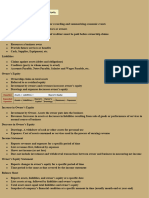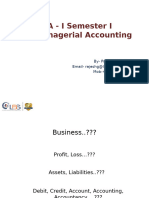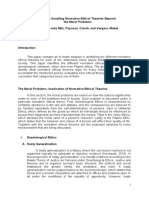0 ratings0% found this document useful (0 votes)
33 viewsKey Terms Introduced or Emphasized in Chapter 4
Key Terms Introduced or Emphasized in Chapter 4
Uploaded by
Faryal MughalThis document introduces key accounting terms that were emphasized in Chapter 4, including accrual, accumulated depreciation, adjusted trial balance, adjusting entries, book value, contra-asset account, depreciable assets, depreciation, immaterial, matching principle, materiality, prepaid expenses, realization principle, straight-line method of depreciation, and unearned revenue. It provides brief definitions for each term in 1-2 sentences.
Copyright:
© All Rights Reserved
Available Formats
Download as DOC, PDF, TXT or read online from Scribd
Key Terms Introduced or Emphasized in Chapter 4
Key Terms Introduced or Emphasized in Chapter 4
Uploaded by
Faryal Mughal0 ratings0% found this document useful (0 votes)
33 views2 pagesThis document introduces key accounting terms that were emphasized in Chapter 4, including accrual, accumulated depreciation, adjusted trial balance, adjusting entries, book value, contra-asset account, depreciable assets, depreciation, immaterial, matching principle, materiality, prepaid expenses, realization principle, straight-line method of depreciation, and unearned revenue. It provides brief definitions for each term in 1-2 sentences.
Original Description:
for
Original Title
defCh04
Copyright
© © All Rights Reserved
Available Formats
DOC, PDF, TXT or read online from Scribd
Share this document
Did you find this document useful?
Is this content inappropriate?
This document introduces key accounting terms that were emphasized in Chapter 4, including accrual, accumulated depreciation, adjusted trial balance, adjusting entries, book value, contra-asset account, depreciable assets, depreciation, immaterial, matching principle, materiality, prepaid expenses, realization principle, straight-line method of depreciation, and unearned revenue. It provides brief definitions for each term in 1-2 sentences.
Copyright:
© All Rights Reserved
Available Formats
Download as DOC, PDF, TXT or read online from Scribd
Download as doc, pdf, or txt
0 ratings0% found this document useful (0 votes)
33 views2 pagesKey Terms Introduced or Emphasized in Chapter 4
Key Terms Introduced or Emphasized in Chapter 4
Uploaded by
Faryal MughalThis document introduces key accounting terms that were emphasized in Chapter 4, including accrual, accumulated depreciation, adjusted trial balance, adjusting entries, book value, contra-asset account, depreciable assets, depreciation, immaterial, matching principle, materiality, prepaid expenses, realization principle, straight-line method of depreciation, and unearned revenue. It provides brief definitions for each term in 1-2 sentences.
Copyright:
© All Rights Reserved
Available Formats
Download as DOC, PDF, TXT or read online from Scribd
Download as doc, pdf, or txt
You are on page 1of 2
KEY TERMS INTRODUCED OR EMPHASIZED IN CHAPTER 4
accrue To grow or accumulate over time; for example, interest expense.
Accumulated Depreciation A contra-asset account shown as a deduction from
the related asset account in the balance sheet. Depreciation taken throughout the
useful life of an asset is accumulated in this account.
adjusted trial balance A schedule indicating the balances in ledger accounts
after end-of-period adjusting entries have been posted. The amounts shown in the
adjusted trial balance are carried directly into financial statements.
adjusting entries Entries made at the end of the accounting period for the
purpose of recognizing revenue and expenses that are not properly measured as a
result of journalizing transactions as they occur.
book value The net amount at which an asset appears in financial statements. For
depreciable assets, book value represents cost minus accumulated depreciation.
Also called carrying value.
contra-asset account An account with a credit balance that is offset against or
deducted from an asset account to produce the proper balance sheet amount for
the asset.
depreciable assets Physical objects with a limited life. The cost of these assets
is gradually recognized as depreciation expense.
depreciation The systematic allocation of the cost of an asset to expense during
the periods of its useful life.
immaterial Something of little or no consequence. Immaterial items may be
accounted for in the most convenient manner, without regard to other theoretical
concepts.
matching (principle) The accounting principle of offsetting revenue with the
expenses incurred in producing that revenue. Requires recognition of expenses in
the periods that the goods and services are used in the effort to produce revenue.
materiality The relative importance of an item or amount. Items significant
enough to influence decisions are said to be material. Items lacking this
importance are considered immaterial. The accounting treatment accorded to
immaterial items may be guided by convenience rather than by theoretical
principles.
prepaid expenses Assets representing advance payment of the expenses of future
accounting periods. As time passes, adjusting entries are made to transfer the
related costs from the asset account to an expense account.
realization (principle) The accounting principle that governs the timing of
revenue recognition. Basically, the principle indicates that revenue should be
recognized in the period in which it is earned.
straight-line method of depreciation The widely used approach of recognizing
an equal amount of depreciation expense in each period of a depreciable assets
useful life.
unearned revenue An obligation to deliver goods or render services in the
future, stemming from the receipt of advance payment.
useful life The period of time that a depreciable asset is expected to be useful to
the business. This is the period over which the cost of the asset is allocated to
depreciation expense.
You might also like
- Iso8583 1993Document128 pagesIso8583 1993Hung Le100% (3)
- Hospitality Industry Accounting GlossaryDocument26 pagesHospitality Industry Accounting GlossaryKathy Holcomb CraigNo ratings yet
- Intermediate Accounting 1: a QuickStudy Digital Reference GuideFrom EverandIntermediate Accounting 1: a QuickStudy Digital Reference GuideNo ratings yet
- Generally Accepted Accounting PrinciplesDocument5 pagesGenerally Accepted Accounting PrinciplesJessNo ratings yet
- GCE O Level Principles of Accounts GlossaryDocument6 pagesGCE O Level Principles of Accounts Glossaryebookfish50% (2)
- Properties of Matter Worksheet 1Document1 pageProperties of Matter Worksheet 1Faryal Mughal33% (3)
- Modals of Suggestion and Advice:: Should, Ought To, Had BetterDocument5 pagesModals of Suggestion and Advice:: Should, Ought To, Had BetterDavid Sibaja JimenezNo ratings yet
- NEC3 Procurement and Contract Strategies GuideDocument28 pagesNEC3 Procurement and Contract Strategies GuideJohn Wood100% (3)
- B-64434en 01Document146 pagesB-64434en 01mt7038No ratings yet
- Chapter - 4 - Key Terms T A C: A D: HE Ccounting Ycle Ccruals AND EferralsDocument2 pagesChapter - 4 - Key Terms T A C: A D: HE Ccounting Ycle Ccruals AND EferralsFahad MushtaqNo ratings yet
- 100 006 Measuring Business IncomeDocument4 pages100 006 Measuring Business IncomeaymieNo ratings yet
- Kamus Akuntansi PDFDocument17 pagesKamus Akuntansi PDFHapsara Bhanu AdhikaNo ratings yet
- Glossary Chapter 4 PDFDocument6 pagesGlossary Chapter 4 PDFBarun Kumar SinghNo ratings yet
- Glossary AccountancyDocument20 pagesGlossary Accountancymohak vilechaNo ratings yet
- Fundamental Financial Accounting Key Terms and Concepts Chapter 5 - Accounting For and Presentation of Current AssetsDocument3 pagesFundamental Financial Accounting Key Terms and Concepts Chapter 5 - Accounting For and Presentation of Current AssetsdanterozaNo ratings yet
- Glossary of AccountingDocument8 pagesGlossary of AccountingSarbuland Khan LodhiNo ratings yet
- Accounting Concepts and ConventionsDocument22 pagesAccounting Concepts and ConventionsMishal SiddiqueNo ratings yet
- Accounting Basics 1Document3 pagesAccounting Basics 1Irene the Fire CatNo ratings yet
- Iprimed 1Document15 pagesIprimed 1mittakollusureshkrishna12345No ratings yet
- Rangkuman UTS (AutoRecovered) (Repaired) (Repaired)Document44 pagesRangkuman UTS (AutoRecovered) (Repaired) (Repaired)Maulani DwiNo ratings yet
- Chapter 1 Accounting Theory Part 3Document24 pagesChapter 1 Accounting Theory Part 3Abdul AlnatourNo ratings yet
- Recognition and Measurement CFASDocument8 pagesRecognition and Measurement CFASLuis PurutongNo ratings yet
- Assorted GlossaryDocument21 pagesAssorted Glossarydarklem0nzestNo ratings yet
- Mercantile Basis AccountingDocument9 pagesMercantile Basis AccountingAshish SinghalNo ratings yet
- Assets Fair ValueDocument10 pagesAssets Fair ValueArulmani MurugesanNo ratings yet
- Amodia - Notes (SIM 3)Document2 pagesAmodia - Notes (SIM 3)CLUVER AEDRIAN AMODIANo ratings yet
- Concept and Accounting of DepreciationDocument14 pagesConcept and Accounting of DepreciationSanzida Rahman AshaNo ratings yet
- Chapter 6: Conceptual Framework - Recognition and Measurement RecognitionDocument5 pagesChapter 6: Conceptual Framework - Recognition and Measurement RecognitionEllen MaskariñoNo ratings yet
- Prepare Financial Report IbexDocument13 pagesPrepare Financial Report Ibexfentahun enyewNo ratings yet
- Financial MGT TermsDocument14 pagesFinancial MGT TermsAmit KaushikNo ratings yet
- Accounting ConceptDocument4 pagesAccounting ConceptRam KumarNo ratings yet
- Bookkeeping GlossaryDocument3 pagesBookkeeping GlossaryMarites RojasNo ratings yet
- Class 15Document14 pagesClass 15Majid IqbalNo ratings yet
- Structure of AccountingDocument62 pagesStructure of AccountingSyafira AdeliaNo ratings yet
- Accrual Accounting: Financial Depreciate Assets Intangible Assets Work in ProgressDocument4 pagesAccrual Accounting: Financial Depreciate Assets Intangible Assets Work in ProgressGesa StephenNo ratings yet
- Managerial Accounting Unit-IDocument33 pagesManagerial Accounting Unit-Ijatan waniNo ratings yet
- Libby 4ce Solutions Manual - Ch04Document92 pagesLibby 4ce Solutions Manual - Ch047595522No ratings yet
- Fabm NotesDocument7 pagesFabm NotescastrojaniemNo ratings yet
- Generally Accepted Accounting Principles - GAAP: Concept DefinitionDocument8 pagesGenerally Accepted Accounting Principles - GAAP: Concept DefinitiontasyriqNo ratings yet
- Adjusting EntriesDocument7 pagesAdjusting EntriesJon Pangilinan100% (1)
- Accounting Chapter 3 SummaryDocument7 pagesAccounting Chapter 3 SummaryHariNo ratings yet
- GAAPDocument3 pagesGAAPEden CheungNo ratings yet
- FAQs For F&a InterviewsDocument13 pagesFAQs For F&a InterviewsVamsi Chowdary KolliNo ratings yet
- Chapter 6 Recognition and MeasurementDocument8 pagesChapter 6 Recognition and MeasurementMicsjadeCastilloNo ratings yet
- Glossary of Financial TermsDocument3 pagesGlossary of Financial Termsmanishaamba7547No ratings yet
- Acc Imp Points 2Document10 pagesAcc Imp Points 2AnilisaNo ratings yet
- Adjusting The Accounts: Learning ObjectivesDocument6 pagesAdjusting The Accounts: Learning ObjectivesArif HasanNo ratings yet
- Module 3 CFAS PDFDocument7 pagesModule 3 CFAS PDFErmelyn GayoNo ratings yet
- Group 2 FmfaDocument38 pagesGroup 2 Fmfaknarfylunjas15No ratings yet
- Accounting Terms: Study Online atDocument2 pagesAccounting Terms: Study Online atpearl042008No ratings yet
- Unit 3: Accounting Terminology - Glossary: Learning OutcomesDocument15 pagesUnit 3: Accounting Terminology - Glossary: Learning OutcomesBhagwat ThakkerNo ratings yet
- Acc. 101-True or False and IdentificationDocument9 pagesAcc. 101-True or False and IdentificationAuroraNo ratings yet
- Adjustments and Aje Overview (1)Document10 pagesAdjustments and Aje Overview (1)Feria Nhessica AvrilNo ratings yet
- Financial Accounting Canadian 6th Edition Libby Solutions Manual 1Document107 pagesFinancial Accounting Canadian 6th Edition Libby Solutions Manual 1sharon100% (68)
- AccountancyDocument3 pagesAccountancyZyrhiemae Kyle EhnzoNo ratings yet
- Finance DefinitionsDocument17 pagesFinance DefinitionsvigneshNo ratings yet
- BASIC-ACCOUNTING_050332Document4 pagesBASIC-ACCOUNTING_050332shemi kasaNo ratings yet
- Lesson 3: Basic Accounting: Completing The Accounting Cycle Adjusting The AccountsDocument18 pagesLesson 3: Basic Accounting: Completing The Accounting Cycle Adjusting The AccountsAra ArinqueNo ratings yet
- Notes For Week 3Document3 pagesNotes For Week 3algokar999No ratings yet
- Inflation Accounting: BY, Nadeem Zehera Prathiksha Pooja J Raheela Banu Ramya JDocument36 pagesInflation Accounting: BY, Nadeem Zehera Prathiksha Pooja J Raheela Banu Ramya JLikitha T AppajiNo ratings yet
- Fixed Assets and DepreciationDocument7 pagesFixed Assets and DepreciationArun PeterNo ratings yet
- Accounting ConceptsDocument16 pagesAccounting ConceptsMani Bhargavi KommareddyNo ratings yet
- FABM AJE and Adjusted Trial Balance Service BusinessDocument18 pagesFABM AJE and Adjusted Trial Balance Service BusinessMarchyrella Uoiea Olin Jovenir50% (4)
- ABM FABM1-Q4-Week-1Document26 pagesABM FABM1-Q4-Week-1Just OkayNo ratings yet
- The Bloodless Coup Concert (Project Managment) PRNTDocument5 pagesThe Bloodless Coup Concert (Project Managment) PRNTFaryal Mughal0% (1)
- Resources Scheduled Resources Available 3 3 3 3 3 3 3 3 3 3 3 3 3 3 3 3Document7 pagesResources Scheduled Resources Available 3 3 3 3 3 3 3 3 3 3 3 3 3 3 3 3Faryal MughalNo ratings yet
- You Are Given A Case Study. You Are Required To Answer The Question Given at The End of Case StudyDocument2 pagesYou Are Given A Case Study. You Are Required To Answer The Question Given at The End of Case StudyFaryal MughalNo ratings yet
- Chicken Manchurian: IngredientsDocument3 pagesChicken Manchurian: IngredientsFaryal MughalNo ratings yet
- FM - Assignment III - Kubra FatimaDocument9 pagesFM - Assignment III - Kubra FatimaFaryal MughalNo ratings yet
- FM - Assignment I - Kubra FatimaDocument15 pagesFM - Assignment I - Kubra FatimaFaryal MughalNo ratings yet
- LeadershipDocument3 pagesLeadershipFaryal MughalNo ratings yet
- ApplicationDocument1 pageApplicationFaryal MughalNo ratings yet
- Student Name: - ScoreDocument2 pagesStudent Name: - ScoreFaryal MughalNo ratings yet
- Difference Between Recruitment and SelectionDocument12 pagesDifference Between Recruitment and SelectionFaryal MughalNo ratings yet
- Example Overview: Synergy SolutionsDocument5 pagesExample Overview: Synergy SolutionsFaryal MughalNo ratings yet
- NameDocument1 pageNameFaryal MughalNo ratings yet
- (721965740) Reading and Spelling 4Document3 pages(721965740) Reading and Spelling 4Faryal MughalNo ratings yet
- Student Name: - ScoreDocument2 pagesStudent Name: - ScoreFaryal MughalNo ratings yet
- Case Study - Groups (1-4)Document2 pagesCase Study - Groups (1-4)Faryal MughalNo ratings yet
- Normative Ethics-Ethics Final ExamDocument7 pagesNormative Ethics-Ethics Final ExamCAIRAH PAYUSANNo ratings yet
- Unit1 HadoopDocument20 pagesUnit1 HadoopSuni SunithaNo ratings yet
- Brewhouse Sizing PDFDocument166 pagesBrewhouse Sizing PDFFEDESORENNo ratings yet
- Copper Hoards of Ancient India (Hauptmann, Andreas & Hughes, Michael J., 1989)Document85 pagesCopper Hoards of Ancient India (Hauptmann, Andreas & Hughes, Michael J., 1989)Srini KalyanaramanNo ratings yet
- Yoga (Level A) CH 2 FinalDocument12 pagesYoga (Level A) CH 2 Finaljkc_iitmNo ratings yet
- List of Books For Class IX Session (2020-2021)Document2 pagesList of Books For Class IX Session (2020-2021)Nandan KhandelwalNo ratings yet
- Cement Testig NotesDocument28 pagesCement Testig NotesSatish Kumar100% (1)
- Service Now Basic Questions For AdminsDocument14 pagesService Now Basic Questions For Adminssattisubrahmanyam100% (1)
- SEVESO HELECO Conference PresentationDocument13 pagesSEVESO HELECO Conference PresentationYanka IlarionovaNo ratings yet
- Special Education:: in The Education ofDocument32 pagesSpecial Education:: in The Education ofJeferson SardengNo ratings yet
- POST-COLONIAL - The Movie in Their Minds - The Asian Diaspora in America (COMPARATIVE ANALYSIS)Document17 pagesPOST-COLONIAL - The Movie in Their Minds - The Asian Diaspora in America (COMPARATIVE ANALYSIS)Jonathan AysonNo ratings yet
- Casa SperimentaleDocument7 pagesCasa SperimentalecldderouynnorandaNo ratings yet
- Mathematics - Level 4 - Pack 2Document42 pagesMathematics - Level 4 - Pack 2Elena HiguerasNo ratings yet
- Name of Patient: Agency/ Area: Diagnosis: Rating: - Assessment Subjective Objective Anxious C Body Weakness Uneasy UncomfortableDocument3 pagesName of Patient: Agency/ Area: Diagnosis: Rating: - Assessment Subjective Objective Anxious C Body Weakness Uneasy UncomfortableNicoAsiñeroNo ratings yet
- Exercise 7 Dynamic Balancing of Rigid RotorsDocument7 pagesExercise 7 Dynamic Balancing of Rigid RotorsAnonymous dqbb02DUhNo ratings yet
- Grammar Review Packet 8 Pronouns Answer Key 1Document13 pagesGrammar Review Packet 8 Pronouns Answer Key 1Frances FangNo ratings yet
- Base I Technical Specs - Vol 2Document314 pagesBase I Technical Specs - Vol 2Mohamed LahlouNo ratings yet
- Frequency Response Analysis and Short-Circuit Impedance Measurement in Detection of Winding Deformation Within Power TransformersDocument8 pagesFrequency Response Analysis and Short-Circuit Impedance Measurement in Detection of Winding Deformation Within Power TransformersRoyer Guerra huamanNo ratings yet
- Sweet Grass 2008Document26 pagesSweet Grass 2008Anonymous 7R6n0f9BY100% (1)
- Department of Treasuries and Accounts, Tamil Nadu, IndiaDocument4 pagesDepartment of Treasuries and Accounts, Tamil Nadu, IndiasnaponumeshNo ratings yet
- Tips Dan Strategi Menembus Jurnal International BereputasiDocument56 pagesTips Dan Strategi Menembus Jurnal International BereputasiKing KoonnnggggNo ratings yet
- 90 03 Q Income Tax On CorporationDocument14 pages90 03 Q Income Tax On CorporationRhoshelle Beleganio100% (1)
- Unifi Home Form Revised - 012020Document4 pagesUnifi Home Form Revised - 012020Muhammad Akmal RazmiNo ratings yet
- Learning From The Land: Indigenous Land Based Pedagogy and DecolonizationDocument15 pagesLearning From The Land: Indigenous Land Based Pedagogy and DecolonizationleoNo ratings yet
- Evaluation Technology For Energy Consumption and Traffic Volume On Railway Traffic Systems and Hitachi's Energy Saving EffortsDocument6 pagesEvaluation Technology For Energy Consumption and Traffic Volume On Railway Traffic Systems and Hitachi's Energy Saving EffortsAhmad TaheriNo ratings yet
- Yandere Ebooks List 13 CompressDocument1,644 pagesYandere Ebooks List 13 CompressTitrax SansNo ratings yet









































































































